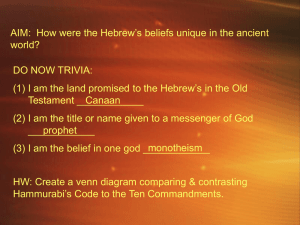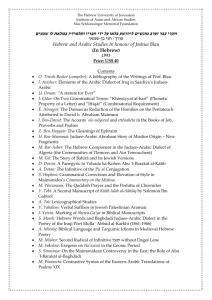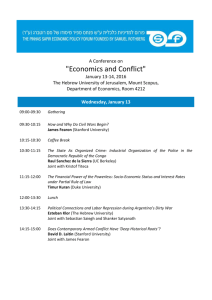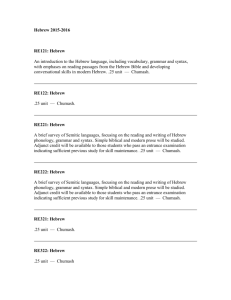gramm-Latin-OrnanE
advertisement
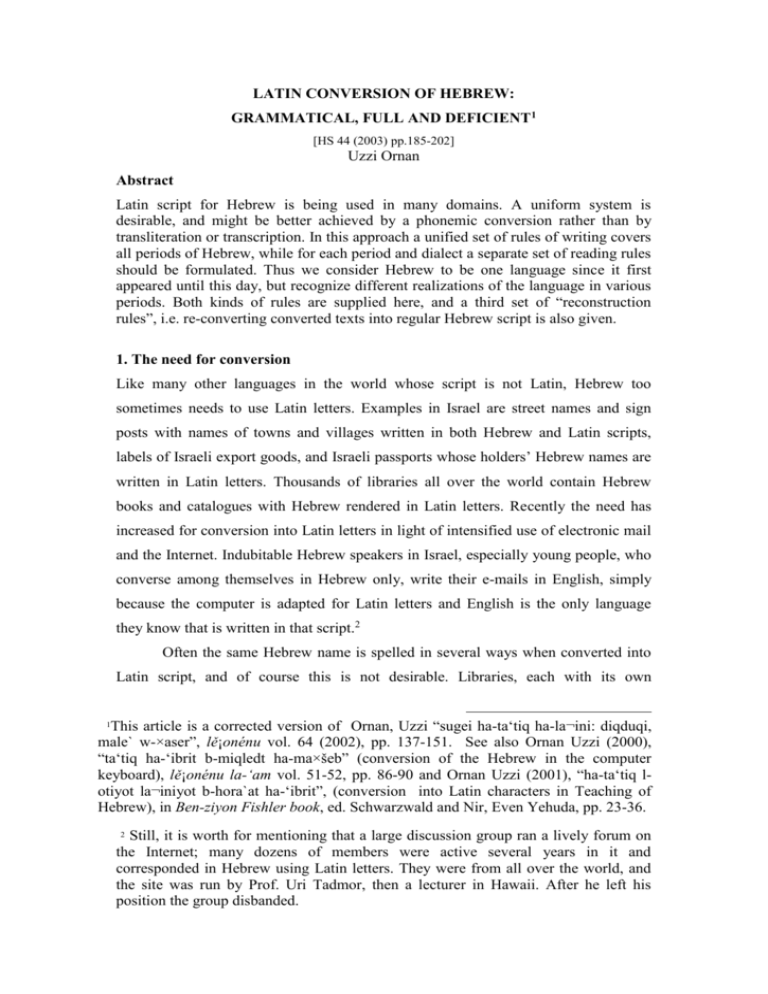
LATIN CONVERSION OF HEBREW: GRAMMATICAL, FULL AND DEFICIENT1 [HS 44 (2003) pp.185-202] Uzzi Ornan Abstract Latin script for Hebrew is being used in many domains. A uniform system is desirable, and might be better achieved by a phonemic conversion rather than by transliteration or transcription. In this approach a unified set of rules of writing covers all periods of Hebrew, while for each period and dialect a separate set of reading rules should be formulated. Thus we consider Hebrew to be one language since it first appeared until this day, but recognize different realizations of the language in various periods. Both kinds of rules are supplied here, and a third set of “reconstruction rules”, i.e. re-converting converted texts into regular Hebrew script is also given. 1. The need for conversion Like many other languages in the world whose script is not Latin, Hebrew too sometimes needs to use Latin letters. Examples in Israel are street names and sign posts with names of towns and villages written in both Hebrew and Latin scripts, labels of Israeli export goods, and Israeli passports whose holders’ Hebrew names are written in Latin letters. Thousands of libraries all over the world contain Hebrew books and catalogues with Hebrew rendered in Latin letters. Recently the need has increased for conversion into Latin letters in light of intensified use of electronic mail and the Internet. Indubitable Hebrew speakers in Israel, especially young people, who converse among themselves in Hebrew only, write their e-mails in English, simply because the computer is adapted for Latin letters and English is the only language they know that is written in that script.2 Often the same Hebrew name is spelled in several ways when converted into Latin script, and of course this is not desirable. Libraries, each with its own This article is a corrected version of Ornan, Uzzi “sugei ha-ta‘tiq ha-la¬ini: diqduqi, male` w-×aser”, lě¡onénu vol. 64 (2002), pp. 137-151. See also Ornan Uzzi (2000), “ta‘tiq ha-‘ibrit b-miqledt ha-maךeb” (conversion of the Hebrew in the computer keyboard), lě¡onénu la-‘am vol. 51-52, pp. 86-90 and Ornan Uzzi (2001), “ha-ta‘tiq lotiyot la¬iniyot b-hora`at ha-‘ibrit”, (conversion into Latin characters in Teaching of Hebrew), in Ben-ziyon Fishler book, ed. Schwarzwald and Nir, Even Yehuda, pp. 23-36. 1 Still, it is worth for mentioning that a large discussion group ran a lively forum on the Internet; many dozens of members were active several years in it and corresponded in Hebrew using Latin letters. They were from all over the world, and the site was run by Prof. Uri Tadmor, then a lecturer in Hawaii. After he left his position the group disbanded. 2 conversion system, are liable to mislead readers, or even to acquire the same book twice just because it has different Latin forms, and the same author appears in different places not as the same person.3 The same street name in different towns in Israel may likewise be written in various forms, and anyone looking for an address in a town or a village in Israel might encounter different spellings and lose his or her way. It is desirable that all kinds of conversion should therefore be made uniform. For almost two centuries books in linguistics have customarily written Hebrew words in Latin letters. The rules of the Academy for the Hebrew Language on conversion into Latin script, adopted years ago, in principle follow what is accepted in the scholarly literature.4 Recently the International Standards Organization (ISO) dealt with Hebrew conversion in a large project that it undertook the preparation of conversions into Latin script for many languages, particularly those of peoples of Asia. In 1999 the draft of standard Hebrew conversion was made into the ISO final version.5 In view of the plethora of conversions for various languages, and the importance of attaining uniformity in Hebrew conversion, this problem merits attention.6 In a special essay distributed on the network ISO/ TC 46/SC2, Pere Casanellas of Barcelona showed how great is the confusion in the conversion of Hebrew authors’ names and book titles; see also Casanellas, Pere (1997), “Transliteratio i Transcriptio de l`hebreu: eines, propostes, questions pendents”, Bulleto de l`Associacio Biblica de Catalunya, vol. 58, pp.5-72 and Casanellas, Pere (2000), “Transliteratio i Transcriptio de l`hebreu: Una nova proposta”, Scripta Biblica vol. 3, pp. 225-362.. 3 See Academy for the Hebrew Language (1957), “klalei ha-ta‘tiq mi-ktab ‘ibri l-ktab latini, Academy for the Hebrew Language memoirs, vol.3-4 (1957), pp. 5-8; 4 FDIS 259-3 (1999). Conversion of Hebrew Characters into Latin Characters - Part 3: Phonemic Conversion (ISO/TC46/CS2/FDIS). See Barry, R.K. (1991), Transliteration Schemes for Non-Roman Scripts, Library of Congress Cataloguing Distribution Service, Washington; Wellish, H.H. (1978). Conversion of Scripts, its Nature, History and Utilization, New York, J. Wiley; Ornan Uzzi (1978), “tkunotaw šell ktab ¬ob” (features of a good script), in a collection of problems of Hebrew script, ed. M. Ater, Tel Aviv, pp.15-23, and the rules for conversion of Hebrew letters at various institutions, such as the rules of the Academy: Academy (1957) ; American National Standard Institute (1975), "American National Standard Romanization of Hebrew”, ANSI 239.25 ; rules of the New York Public Library etc.. An explanatory description of the ISO FDIS 259-3 (1999) is also given in Ornan Uzzi (1993). “ta‘tiq fonemi šell ‘ibrit b-otiyot la¬iniyot” (phonemic conversion of Hebrew into Latin in ‘alon asmi, journal of special libraries and information centers in Israel, vol. 19, pp.8-14. 5 6 2 2. The problem 2.1 Augmenting Latin alphabet The main difficulty in adapting an alphabet that is not the language’s original one is that the target letters do not always supply or are not always suited to the store of sounds and phonemes of the converted language.7 Many speakers of foreign languages come up against this problem when aiming to accommodate Latin script to themselves. For example, the “Latin” letter j is not known at all in Latin itself. When Spanish needed to signify i as a consonant differently from i as a vowel, the existing alphabet was augmented by a letter not found previously in it. (In fact this letter is an elongated i.) The same applies to the letters u and w, which also were added for the purpose of differentiation from v in some languages at various periods. These letters were created out of existing Latin letters by modification of their form. This is the first way of adapting Latin script to other languages. In other languages other ways were devised. In them graphemes based on existing letters were added by adding diacritic marks to an existing Latin letter. In this way the proximity of the required sound to the sound usually signified by the Latin letter was indicated, while the distinctness of the required sound was preserved. Such was the case with French, for example, which has a large number of vowel sounds, far more than the Latin script can supply. In that language various signs were added above the letters signifying vowel sounds. Another example is the difficulty felt in many languages of denoting the sound [sh]; Czech and other languages contrived the well known solution: to add a sign (the hatchek) over the Latin s, that is, ¡. A third method is common in several languages: combination of two letters (or more) to signify one required sound. For example, the sound [¡] in English is denoted by sh, in French by ch, in German by sch, and in Italian by sci or sce. We may state right now that this third method is not suitable for Semitic languages. In these, most words are constructed out of roots and patterns. For a pattern to be clearly evident, each radical of a root must be signified by one letter This applies to every alphabet that is not original to the language, such as the Asiatic languages of the former Soviet Union, which were adapted to the Cyrillic alphabet, or languages of Muslim peoples that were adapted to the Arabic alphabet (Persian, Urdu, etc.). But our concern is with conversion into Latin letters. 7 3 only. A combination of two letters will distort both the picture of the pattern and the clarity of the root. Compare, for example, gamar, in the pattern _a_a_ with shamar. Or masmer in the pattern ma_ _e_ with mashder In each of these patterns there are three slots, into each of them one radical letter is absorbed. Naturally, every slot has to be filled by one letter; but if we use sh instead of one letter, the reader may conclude that there are two slots. Using two letters instead of one removes the simple possibility of comparing words of the same pattern, and thus withholds from the reader information that at times is of great value, and we may even mislead him or her. For example, the letter chain shamar is similar in form to a name such as smadar, whose structure is _ _a_a_ and not _a_a_. 2.2 Conversion for all periods and all pronunciations We are greatly concerned to establish a conversion of Hebrew that can reflect all the periods of the language. It would be an enormous loss if the proposed conversion were good for use by the Hebrew of only one of its periods. The Academy for the Hebrew Language is obliged to preserve the development of the Hebrew language in the framework of the Hebrew which has been transmitted down countless generations. The Academy could by no means be party to a conversion that might perhaps reflect the accepted pronunciation of one particular period, such as Israeli Hebrew, but would be useless for the Hebrew of a different period, such as the language of the Bible or of the Sages. Furthermore, we must seek a method of conversion that will allow not only expression of all the periods and all the versions, but one that will also portray all the existing dialects and all the pronunciations of the various communities. This is not a “mission impossible”, as it may seem at first sight. 2.3 Writing rules separately and reading rules separately To fulfill the task described in 2.2 above, note that in every language a distinction exists between the rules of writing and the rules of reading. In Hebrew too these two kinds of rules are kept separate. For example, in writing we distinguish the letter ת (<taw>) from the letter ¬<( טet>), and woe betide anyone who confuses them. Not only will the Academy for the Hebrew Language reject his or her candidacy to serve there as a clerk, but even any ordinary commercial business will refuse to employ a person who cannot write without spelling mistakes. 4 But reading – that’s a different matter altogether! In fact, the rule of reading taught in schools in Israel and abroad regarding the written letters <taw> and <¬et> is the following: “Pronounce <¬et> like <taw>”. Similarly, “Pronounce <qo¾> like <ka¾>”. And as we know, people’s preferences vary about a reading rule such as “Pronounce <‘ayn> like <ale¾>”. In contrast to the writing rules, which are largely inflexible, the reading rules, namely the realization rules, vary from community to community, and in fact are formulated according to the reader’s desire. But the reading rules do not affect and do not determine the writing rules. These are firmly fixed, and if our intention is to preserve the unity of the Hebrew language for ages to come, it is quite right that they continue to be firmly fixed forever. We must stress this: the writing rules and the reading rules of any language are interwoven as a single system, but every language has its own system of writing rules and reading rules. The reading rules of one language cannot be operated in another. For example, the reading rules of Italian are entirely different from those of Swedish, and anyone who confounds them is in trouble. 3. Transcription and transliteration We have long since learned to recognize two ways of formulating the rules of conversion. Later we shall show a third way, but first let us consider the special nature of the two known ways. Transcription is writing down the sounds heard by the listener. From the content of the previous section, we may define transcription as the method that demands formulation of the writing rules according to the reading rules practiced in the given period. Let us take the transcription of the Hebrew letter <¬et>: because the rule for reading <¬et> is “Read <¬et> like <taw>” the transcription approach has to be, “Write <¬et> as you write <taw>”. Because this “reading rule” does not exist in all times and for all pronunciations, the transcription approach in fact eliminates the possibility of allowing the process of conversion faithfully to express all periods, all pronunciations, all dialects, and all communities. This approach obviates a uniform conversion of the language in its various periods and pronunciations. Furthermore, it will always elevate one dialect above another, and will prefer a “superior” pronunciation to an “inferior” one. Thereby it in no way permits the “inferior” a place worthy of recognition. 5 Moreover, the transcription approach is not only dialect-dependent but also reader-dependent. If you tailor your Hebrew conversion method to English speakers, you will have to transliterate <shin> [¡] as sh, but for French speakers it will have to be ch. If you want to transliterate <×et> [×] for English speakers you will no doubt be able to write ch, but French speakers will pronounce that <shin> [¡]. Now for Spanish speakers you will have to transliterate <×et> by j, but French speakers will understand this as the sign representing <¦ayn> [¦]. So the transcription will vary not only according to the chosen dialect, but also according the end-users who have to read Hebrew in Latin script. Transcription is indeed the practice in glossaries for tourists. But a tourists’ glossary for Argentineans will be different from that for French-speaking tourists, and different yet again from that for English-speaking tourists. Every tourists’ glossary is intended for speakers of one particular foreign language, and it reflects one particular Hebrew (mostly the “general Israeli” pronunciation, which equates <‘ayn> with <`alep> and <×et> with <½a¾>). When it comes to establishing principles for Hebrew conversion we must therefore dismiss the transcription approach. In addition to all its above-stated deficiencies, this method does not permit reconstruction of the original Hebrew text, and this feature is in fact the best sign of the value of a conversion method. Here we should add this: in scholarly essays on the Hebrew language published in journals in a foreign language it is especially important to use a conversion that allows the reader to reconstruct the Hebrew word with which he or she is unfamiliar. First, this will allow the reader to associate it with other words close to it, and also he or she will be able look it up in a Hebrew dictionary and find its meaning. A writer who does not do this is liable to baffle readers, some of whom at least are unable to guess what the word is in the original Hebrew script if they have before them a conversion based on transcription, which is essentially phonetic. The second method is transliteration. By this method every letter in the original script is transliterated into a matching letter in the Latin script. We saw above that if a matching letter does not exist in Latin script, a new letter is created, and we observed the advantage of the diacritics in the domain of creating a new letter, particularly for a language like Hebrew (2.1 above. On the use of the computer see below). But with Hebrew transliteration the problem is which version of the Hebrew script we are transliterating. For the usual unpointed version of the script, conversion 6 by the transliteration method is quite useless. Whoever reads a text in Latin letters expects to find in the words before him or her all the vowels that exist in them. But transliteration of unpointed script does not supply the vowel signs, except insofar as letters denoting vowels appear in the Hebrew text. Here too it is not all plain sailing, because how can we know that the letter <waw>, for example, is properly transliterated as o or as u, and perhaps altogether as w (or v in transcription)? Likewise <yod>: should its transliteration be i or ei or e, or even a (e.g., in the word staw)? Transliteration of pointed Hebrew script is not problem-free either. First, this version of the script is hardly used, and most Hebrew texts down the generations and today are written without pointing. In addition, very few people know correct pointing, and handling such transliteration is a challenge that the readership concerned cannot meet. If you want to transliterate a biblical text, which is pointed from the outset, this is obviously possible; indeed, in scholarly essays on Hebrew, especially those written in another language, the transliteration method serves without notable difficulty. One just has to be sure to find the manifold printer’s signs, with meticulous precision, as required by transliteration. The second problem is that a considerable part of the vowel signs are not required at all for grasping the word’s structure as they are self-evident, that is, they are obligatory in those circumstances. These two methods are not convenient, and each has its own drawbacks. The ISO conversion has none of their disadvantages. Furthermore, it is uniform for every Hebrew text, for every period, for every dialect, and for every community’s pronunciation, as remote as it may be. 4. Phonemic conversion 4.1 The need for phonemic conversion In the search for the best method of converting a language from one script to another, the starting point is usually the language’s national script. For example, if the script is Greek or Cyrillic the task of converting it into Latin is not hard. This is because Greek and the Slavic languages that use Cyrillic script enjoy a fair representation of the sounds and phonemes in that language, and the conversion problem is mainly the technical one of adapting suitable Latin letters for the letters in the national script. Even in Ethiopian script (Ge`ez or Amharic), this means is possible. If a sign is 7 missing we have already found the solution: add a sign! This may be a proper letter (j, u, w) or a diacritic (¡,×, ś, é, è, etc.). This is not the case with a script such as Hebrew, whose usual presentation does not show all the word’s elements, and in whose pointed presentation displays a considerable number of phonetic signs that are superfluous because they arise naturally from the word’s structure. The problem also exists in Arabic script, which serves for Arabic and Persian (and other languages), even though their voweled presentation does not have many superfluous items since this script is principally phonemic. Yet we can circumvent the existing script entirely, and convert the word’s structure directly into the new script as it exists in the language. The diagram shows how it is done: The word’s theoretical structure Phonemic conversion The word as it sounds original writing The word as it is written in the original script transcription The word’s sign in the converted script transliteration We can write down the word’s theoretical structure by means of the phonemes. The phoneme is a theoretical concept, and like any theoretical concept it is realizable not necessarily in one way only. The product of the realization of phonemes is sounds. So of course, the square in the diagram marked “The word as it sounds” can, at various times and in various dialects, contain different sounds; but the square marked “The word’s theoretical structure” is fixed and endures throughout all the periods of the language. If we give it signs of letters from the Latin alphabet, including diacritics as required (or other signs found on the computer keyboard), these letters will serve us well as writing rules for all periods of Hebrew, all the pronunciations of the communities, and all the dialects. For every period or dialect we will only have to formulate the specific reading rules, but no writing rules. 8 4.2 Different kinds of reading rules In respect of “The word’s signs in the converted script” we operate reading rules according to the required pronunciation. If one wishes to read in the version of the Jews of Yemen, one proceeds to formulate the appropriate reading rules; if one wants the reading rules of the Jews of Jerba, one will act in accordance with what one has studied and found out. And if we wish to present the reader with the prevalent pronunciation in Israel today, then too we shall formulate the familiar rules, knowing the difference between what is written and what is heard around us. In the next section we present the conversion rules (writing rules). Most of the phoneme signs set forth here are arranged according to the final standard of the ISO (FDIS 259-3, 1999).8 As stated, in essence they hardly deviate from the form of conversion decided by the Academy for the Hebrew Language in 1957. Detailed comments are given later. 4.3 b,k,p (and g,d,t) in phonemic conversion In keeping with the fundamentals presented here, the different pronunciations of the same phoneme must always be signified by the same letter, for example, the phoneme /b/. At first sight this principle is likely to cause surprise, especially when the Latin script seems to afford us a particular letter for each of the Hebrew sounds of that phoneme. Nevertheless, it is important that this principle be preserved. Otherwise, we turn the two sounds of the same phoneme into two phonemes, thereby wholly altering the language structure, assigning the conversion to a separate language called “Israeli Hebrew”, and preventing the possibility of using this same conversion for other pronunciations of Hebrew. It is worth noting here that in Hebrew script too the phoneme /b/ is always signified by the same letter ב, even though it is sometimes pronounced hard, plosive [b] and sometimes soft, fricative [v]. Furthermore, each of the three phonemes /g/, /d/, and /t/ in our present-day Israeli pronunciation has only one realization, but we are well aware of pronunciations in past and present communities where these three phonemes had two pronunciations each. The problem Since this standard has been adopted, the E-mail authorities enlarged the range of acceptable letters, especially in attachments. Now the range is up to number 255 in ASCII. It actually gives almost all diacritic signs that are needed, with small changes, such as ĥ instead if × for ×<( חet>). We therefore changed some of the original characters of FDIS 259-3 (1999) in what follows. In Ornan Uzzi (2003), The Final Word - mechanism for word generation in Hebrew, University of Haifa Press , converted script explaining many points has been introduced, especially in flowcharts. 8 9 is readily solved on the basis of the distinction we have made between writing rules and reading rules. By the writing rules, you always write the letter that signifies the phoneme, while the reading rules include some that regulate the sounding of this letter in this or that realization. In a later section on the reading rules we shall analyze this subject in precise detail. It mainly concerns the three consonants b, k, and p.9 5. Conversion rules (writing rules) 5.1 Conversion of consonants converted Letter converted letter Converted Lette r ק י א q y ` ר ך, ּכ,כ ב,ּב r k b ש ל ג,ּג l g ¡¡ ש ם,מ ד,ּד Ð m d ת ן,נ ה t n h 'ג ס ו ¨ s w 'ז ע ז ¦ ‘ z 'צ ף,פ,ּפ ח ¥ p × (or ĥ) ץ,צ ט ¬ c )or ç( Most letters with diacritics may now be used for electronic mail and the internet (see note 6). Therefore, the ISO standard, which made possible the use of some alternatives to letters with diacritics, became surplus. The only possible difficulty may 9 The claim that the phonemes /b, k/ and /p/ in Israeli Hebrew split, and each became two phonemes ( as Weiman, R.W. (1950), Native and Foreign Elements in a Language, Philadelphia, and Rozen, H.B. (1957), ha-‘ibrit ¡šellanu, Tel Aviv) is possible, but at the heavy price of an excessive burden on the morphology of Israeli Hebrew as a separate language. Moreover, it scarcely allows examination of Hebrew down all its generations as one language, and most Hebrew speakers are extremely interested in keeping such an approach. Against this argument it is easy to present another method, like that published in Ornan Uzzi (1973b), “×uqqim musdarim w¬a‘nat ha-hitpacclut ha-fonemit $e-`err‘a l- b’k’p’ ” (ordered rules and the claim for phonemic splitting of b’k’p’) in Ornan Uzzi ( ed. 1973) miqra`a l-torat ha-hege (Hebrew Phonology Manual) Jerusalem, Academon, pp. 333-359, and in Ornan Uzzi (1974), “ordered rules and the so-called phonologization of ancient allophones in Israeli Hebrew”, in proceedings of the 11th international congress of linguists, ed. L.Heilmann, vol.2, pp. 1023-1036. These articles put forward a clear and uniform system of Hebrew phonemes that has existed throughout the ages of Hebrew. It is founded on the accepted linguistic distinction between phonemes – theoretical concepts expressed in “writing rules” – and sounds – observable entities expressed in “reading rules” (realization rules). The present proposal is constructed on the principle of the perception of Hebrew down all its generations as a single language. 10 be with ×. In case it is not accepted by the e-mail, in our conversion we can use either ĥ or the letter x instead.10 We should note that the letter <cadi> ) (צis rendered here by the Latin c, not z, as in the ruling of the Academy for the Hebrew Language (1957). The reason is that this Latin letter (z) is already laden with one diacritic, and this is to designate the sound <¦ayn> )'( (זž), found in Hebrew words of foreign origin. Better to lighten the load of sundry diacritics on the same letter. The letter c has often been suggested for converting <cadi>. To allay the oddity of the rendering c, it may be replaced by ç. The Appendix gives examples of names of places with the proposed conversion, and there we use ç. 5.2 Conversion of vowels The five vowels are a, e, i, o, u; a sixth is the combination of e and i. This last designation is necessary only for conversion of the full ceire, the vowel signified in Hebrew script by the letter <yod> )( ֵ י. For example, the Hebrew word bych )(ביצה converts to /beica/. We shall consider the ×a¬a¾s below. 5.3 Grammatical conversion 5.3.1 Attached Particles Let us preface the discussion with an important practical point. Years ago the difficulty caused by the practice of attaching the Hebrew short particles to the following word was pointed out. Attention was drawn to words misconstrued when the attached particles was mistaken for a part of the word following it. Or the reverse: a letter that might be an attached particle at the beginning of a word could be thought not to be a part of it.11 To overcome the problem, the conversion ruling of the Academy for the Hebrew Language contains the instruction to separate the definite article ha- from the succeeding word by a hyphen. 10 The ISO standard 259-3 suggests other possible signs for e-mail: @ for ¬, & for ‘, $ for ¡, gof ׳z ,¨ rof ׳r ¦׳, c ׳for ¥. These characters are easy to use in any e-mail. 11 Such as the old controversy over the word kaddur – ka-dur, or the (relatively) new discovery of Ugaritic BCQLWN (/bicqalon/ or /b-ciqlon/). We may note that in the books of the Quppat Hasefer publishing company, active in London in the early 1920s, the short particles were separated from the following word by an inverted comma. 11 The ISO standard likewise requires separation of every short particle, akin to the case of the definite article ha-. Furthermore, even where the short particle necessitates doubling of the first consonant of the word (e.g., ha-, ¡e-, or mi-), no double letters are to be written after the hyphen. This convention is intended to make it easier for the reader to identify the word or find it in the dictionary. For example, the word hassus (“the horse”) will be rendered /ha-sus/. 5.3.2 Phonemic conversion and pointing We distinguish the word’s theoretical structure, which can be rendered through phonemic notation, from its pointed form. True, we build the Hebrew word’s theoretical structure mainly according pointed texts handed down to us from antiquity, but the pointed word does not convey faithfully the theoretical structure alone. It adds to it various details of its sounding, namely phonetic, not phonemic, elements. For example, the furtive patta× is not part of the theoretical structure of the word. In words ending in one of the consonants h, ×, or ‘ not preceded by a qamac or a patta×, a furtive patta× should be added. The furtive patta× is a manifestly phonetic sign, and should not be included in the theoretical, that is, phonemic, expression of the word, even though it is part of the pointing. The same applies with the last vowel of segolite nouns. Their theoretical structure is characterized by ending in two consonants without an intervening vowel, but the pointed version of segolite nouns contains the vowel realized before the last consonant. This is not a phonemic vowel, but part of the phonetic notation of the word. Grammatical conversion, therefore, will not convey all the items of the word’s pointing, but it will contain everything needed to be known about the word’s structure, and in this manner also provide all the details about the pointing. 5.3.3 The problem of the ×a¬a¾s The problem of the ×a¬a¾s is not at all that simple in the conversion described here, namely grammatical conversion. As we know, ×a¬a¾s indicate the realization of a cluster of consonants, the first of which is a guttural. That is, they do not apply to phonemes but to certain sounds. In principle, there is no difference in the structure of the words /yladim/ [yeladim], /klabim/ [klavim], and /‘badim/ [‘avadim]. The matter 12 is also evident from a comparison of the their singular forms (/yeld, kelb, ‘ebd/). 12 We do not consider the shewa sign under the first letter in the words /yladim/ and /klabim/ as the sign of a phoneme. In essence, the shewa instructs that the letter above it is to be pronounced, and is not silent (see the pointing of )יששכר. Therefore, the shewa should not be part of grammatical conversion.13 Is this the rule with ×a¬a¾ also? At first sight, it cannot be. Good conversion is manifested in the ability to reconstruct the original script from it, so if in grammatical conversion there is no explicit sign for the ×a¬a¾ how may we reconstruct the pointed word? But the essence of ×a¬a¾s is determined by simple rules, plus finite lists of exceptions – actually only of words with ×a¬a¾ qamac or ×a¬a¾ segol. The reader of grammatical conversion has to be equipped with this list (or it has to be inserted into the computer program for pointing: see below), and then it will be possible to reconstruct the pointed version and properly designate the ×a¬a¾s in it. All the rest will be designated by ×a¬a¾ patta×. 5.3.4 Long and short vowels The distinction between the two kinds of pointed vowels, a short vowel and a long one, is clear from the word’s structure, and is made mainly according to the structure of the syllable. Here too, except for words that can be given in a list, the required vowel is obtained according to distinct rules. Certainly, words may be interpreted by their context or their meaning as a noun or a verb, or as an absolute noun or a construct )(נסמך. But we want to get all the information needed from the word itself, not from the context. In such a case it is correct sometimes to add a sign to the word, namely a hyphen after it. This hyphen will indicate a noun in construct or a finite verb. For example, /×akam/ will be understood as the rendering for חָ כָם, while /×akam/ will be the rendering the verb חָ כַם, and ֲחכַםwill be written /×kam-/. Likewise /šul×an/ This rendering is not meant to describe any stage in the history of the words, but for their theoretical presentation only. 12 13 (see Garbell, Irene (1959). “ma‘madam ha-fonemi šell ha-šwa`, ha-׬apim w-šell bgdkpt ha-rpuyim ba-‘ibrit ha-masortit” (phonemic state of the shwa, of the ×atep and of bgdkpt), lešonenu, vol. 23, pp.152-155 and Ornan Uzzi (1973a). “biccu‘eihem ¡šell crorot fonemiyim” (realization of phonemic clusters), in Ornan, Uzzi (editor) 1973, miqra`a l-torat ha-hege (Hebrew phonology manual), Jerusalem, Academon, pp. 186190. 13 is the converted ( שולחןabsolute) while /šul×an-/ renders the construct form. This rule distinguishes /zulat/ ( זּולָתnoun, without hyphen) from /zulat-/ ( זּולַתpreposition, with hyphen). Grammatical conversion is appropriate for use by linguists and philologists. In the conversion proposed here we can convey faithfully and with perfect accuracy the structure of every Hebrew word. This conversion is more precise than the pointed Hebrew version, even if it does not include a visible distinction between short and long vowels, and even if it has no special sign for ×a¬a¾s. 5.4 Full conversion In grammatical conversion we do not convert non-phonemic vowels, such as shewa (“na‘‘”), furtive patta×, or 5the auxiliary segolite vowel, but anyone who is not a linguist will be hard pressed to produce correct grammatical conversion. Furthermore, the lay reader too will have to become accustomed to grammatical reading. For example, it doesn’t have furtive patta× (e.g., [tappua×] –> /tappu×/), and at times shewa is pronounced as the vowel e, but it is not written down in grammatical conversion (e.g. [yeladim] –> /yladim/). The same applies with ×a¬a¾s, which are not designated (e.g. [‘avadim] –> /‘badim/), nor is there a sign for the auxiliary segolite vowel (e.g. /na‘r, yeld/). Along with the grammatical conversion it is therefore worth presenting a conversion that will somewhat facilitate matters for the converter and the reader, for example, /yeladim, do’ar, yeled, tappua×, ‘abadim/. Such a facilitating conversion may well be named “full conversion”. See also the end of section 5.5. A further easing to be considered in the framework of “full conversion”, regardless of earlier comments on the two pronunciations of b, k and p, is to designate the soft pronunciations of these phonemes by a line, for example, bak, ×ob, gu¾. The addition of such a softening line will be especially useful in textbooks of various levels, on road signs, and in street names. Examples are Har Tabor, Çri¾in, Zkarya (more examples are given in the Appendix). 5.5 Defective (Contracted) conversion Doubling of a letter (dagesh forte) in grammatical conversion is written as a combination of two identical letters, for example, [nagar] –> /naggar/. But here too the lay converter is liable to encounter difficulties, and to ease his or her path we can 14 point out another way of converting, a way in which the doubling is written as one letter only. This way may be called “defective conversion”. It is worth noting that the reading of doubling does not trouble the lay reader either, so only writing is at stake. Hence, if it is a question of writing in textbooks, on road signs, or the names of villages or city streets, writing anyway done by those in charge of it, the doubling of a letter may be rendered as a repeated letter, according to grammatical conversion. However, anyone seeking an easy way by writing doubling as one letter must nevertheless write double b, k, and p whenever these letters are at issue. If the pronunciation is plosive here, and a vowel comes before such a consonant, a doubled letter has to be written or we shall lead the reader astray: compare /tikkon/ (=[tikon] (תּכֹון ִּ with /tikon/ (=[ti½on] (תיכֹון ִּ , compare /dibbur/ with /dober/. See the reading rules (section 6) where this subject is set out in detail. The doubled letter calls for yet another comment: it sometimes happens in a word that two identical letters are adjacent (without an intervening vowel), but they are not a doubling of the letter, for example, ×oggim. To avoid error, in the conversion the letters have to be separated, and at the place an underscore ( _ ) is added: /×og_gim/. Without this it would look like a doubled letter here. This addition is best retained in all forms of this conversion, but we can stretch a point with the writing of e instead of the underscore, in keeping with the “full conversion” approach: ×ogegim. One more detail: in deficient conversion it is permitted not to write א <`alp>=[`ale¾] at the beginning of a word (in grammatical conversion it is preferable to write it). Having presented the kinds of conversions we can turn to the rules of reading. 6. The reading rules (rules of realization) 1) The pronunciation of letters designating consonants is made to approximate as closely as possible what is usual in many languages, and comparison to the Hebrew alphabet according to the table above is our guide (it is formulated mainly for Israeli Hebrew). 2) Each of the three letters b, k, and p represents two pronunciations. They will be pronounced in their fricative (“soft”) realization a) when the letter is located after a vowel and is not doubled: /mibdaq/ [mivdaq] /šub/ [šuv]. 15 b) when the letter is at the end of the word even if it is doubled: /lebb/ [lev]. c) when the letter is located after a consonant that is the beginning of a syllable: /bki/ [bki], /dbaš/ [dvaš]. d) when the letter stands for the 3rd radical (<lamd>) in the forms pa‘la, pa‘lu, po‘lim, po‘lot . The reason is that in the basic form there is a vowel before this letter. Thus for /hadpu/ read [had¾u]= [hadfu] (basic form /hadap/); for /garpa/ read [gar¾a]= [garfa], for /karka/ read [kar½a]=[karxa], for /gorpot/ read [gor¾ot]= [gorfot]; for /corbim/ read [cor¼im]= [tsorvim]; for /corkim/ read [cor½im]= [tsorxim]. In these and similar cases, in the basic form of the word (as noted above) a vowel precedes the consonant that designates this letter, and the fricative sound is preserved in inflexion also. But in a word such as /harpu/ (imperative of /hirpa/), the p will be pronounced plosive (hard), because in the basic form (/hirpa/) there is no vowel before the letter p. e) With the suffixes /ka/, /kem/, /ken/ the pronunciation is always soft [k]. 3) Every doubling of consonants will be rendered as a single consonant: /sullam/ [sulam], /naggar/ [nagar]. 4) In grammatical conversion: when h or × or ‘ is at the end of a word, and is not preceded by a vowel a, unaccented a will be inserted before it: /tappu×/ [tapua×], /ru×/ [rua×]. 5) In grammatical conversion: words that are not verbs in the past tense that end in two consonants, and the second of them is the morpheme t, will have an unstressed vowel e inserted between these two consonants. But if one of the consonants is a guttural, the added vowel is a, and if one of them is y, the added vowel is i; for example, /no‘r/ [no‘ar], /tayš/ [tayiš], /degl/ [degel], šomert [šomeret]; but /šamart/ [šamart]. 6) In grammatical conversion: the vowel e will be inserted between two consonants at the beginning of a word if the sonority of the first is not lower than that of the second, for example, /yladim/ [yeladim] but /klabim/ [klavim]. 16 7) The accent in most words (and their inflexions) is on the last syllable, except for verbs with the suffixes ta, ti, and nu, nouns with inflection suffixes enu, eika, eiha, einu and words subject to reading rules 4 and 5. 7. Reconstruction rules An ironclad condition of good conversion rules is that the words in the original script can be reconstructed. Note that this is the first in importance of the general guiding principles of conversion of the ISO. The conversion proposed here upholds this feature in full. Earlier we mentioned the possibility of reconstruction into pointed script. Here we set down the rules for reconstruction of the converted text into unpointed script (the rules must be followed in the given order).14 1) Doubling of a consonant will be converted into single letter only. 2) Every consonant will be converted into the matching letter according to the table in section 5.1. 3) ei will be converted into the letter <( יyod>). 4) a and e in the middle of the word will not be converted, nor will a when it is at the end of the word in the morphemes ta and ka. 5) a and e at the end of the word will be converted into the letter <( הhe`>). 6) o and u will always be converted into the letter <( וwaw>), but for a few exceptions in a list which will not be converted , e.g., /`omnam/ )(אמנם, /×okma/ )(חכמה. 7) Final i in a word will be converted into the letter <( יyod>): /drušim/ = דרושים, /naqi/ = נקי. Also i in the middle of a word followed by a single consonant (or a doubled consonant) will be converted into <( יyod>): /tinoq/ = תינוק, /tippol/ = תיפול, but /migzar/ = מגזר, because the i is followed by two different consonants. 8. In closing The present proposal is meant to uphold the existing rules laid down by the Academy for the Hebrew Language (1957), and it hardly diverges from them. Moreover, Computer programs for the reconstruction of grammatical conversion (in a version for electronic instrumentation) have been written, and they operate flawlessly. Their printout is an unpointed text in Hebrew script, or a pointed Hebrew text. The program that reconstructs Hebrew words in unpointed script will willingly be sent free of charge to anyone interested. Please contact the author, or download it from this site: http://www.cs.technion.ac.il/~ornan (the program’s name is ktab10.exe). 14 17 nothing in this proposal creates a contradiction between grammatical conversion and the facilitating conversions: all have the same letters and the same auxiliary signs. The phonemic approach underlying the proposal is suitable for all periods of Hebrew down the generations, without forfeiting a single essential detail of it. The advantage of the method is evident in its capacity for complete reconstruction into any version of Hebrew script that we possess. The “full” and the “deficient” forms of the conversion are equally able to serve as a basis for the desired reconstruction. These features impart important advantages to the present proposal. The Academy for the Hebrew Language bids us preserve the Hebrew passed down to us. It cannot become shackled to momentary needs, as it were, such as making itself readily available to English-speaking tourists. Hebrew (like every other language) cannot be written by the writing rules of another language, nor can it be read by the reading rules of another language. Furthermore, no self-respecting nation will alter the nature of its language in an attempt to make it “easy”, so to speak, for visitors and tourists to pronounce the words in its language. Here we need only mention Norway, where the city street signs always bear the Norwegian word GATE. But although this word is pronounced yateh (with penultimate accent), and every English speaker misreads it, it would never enter any Norwegian’s mind to replace the signs with something easier on the American ear. This is also the case in France, in Italy (have you ever eaten GNOCCHI?), and in every other country holds its culture dear. Appendix: Suggested names of Israeli road signs in Latin conversion. In grammatical conversion Miçpe מצפה £murat ªula ©at ג'ת, Gadot גדות, ªulda שמורת חולה, ¢de boqer חולדה שדה בוקר, «irat Karmell In facilitating conversion Yeru××am Ya‘ala ירוחם, Wered ha-Galil ורד הגליל, Çe`elim יעלה, ‘ein ªarod עין חרוד, Le¼ona 18 לבונה, צאלים, טירת כרמל Har Ta¼or הר תבור, Z½arya Har Kabbir הר כביר, «¾a×ot זכריה, ¡Pa¬¬iš Ness ‘ammim פטיש, Newe £a`anann נס עמים, £izza¾on טפחות, נוה שאנן, שזפון, ¡K¼iš allon כביש אלון, ‘ein ayyala עין איילה, Çomet ha-nege¼ צומת הנגב, ¡¡ Ma‘ale ha-×amišša Ǿat צפת, Çippori ציפורי. 19 מעלה החמישה,

